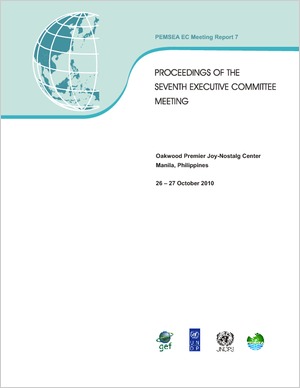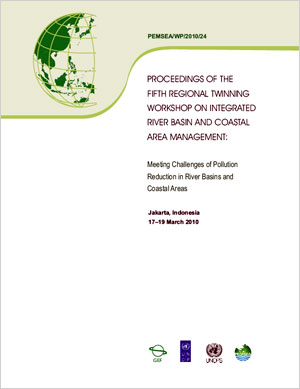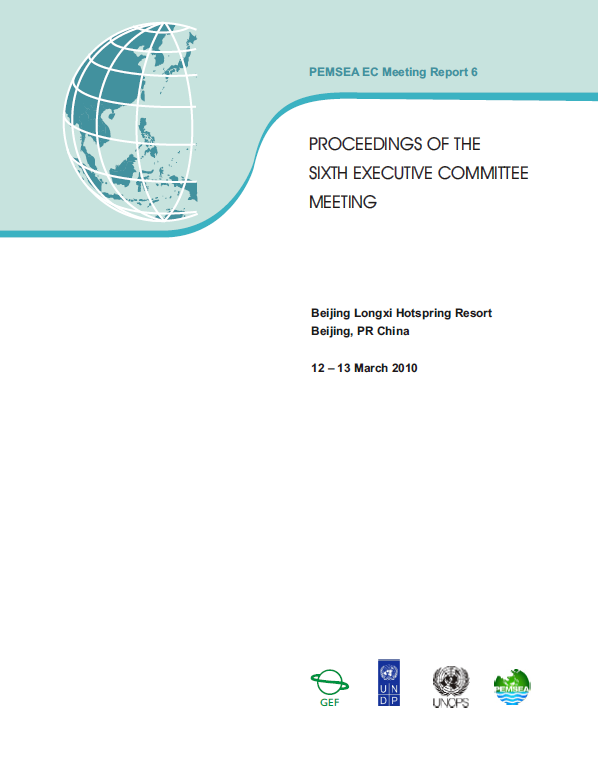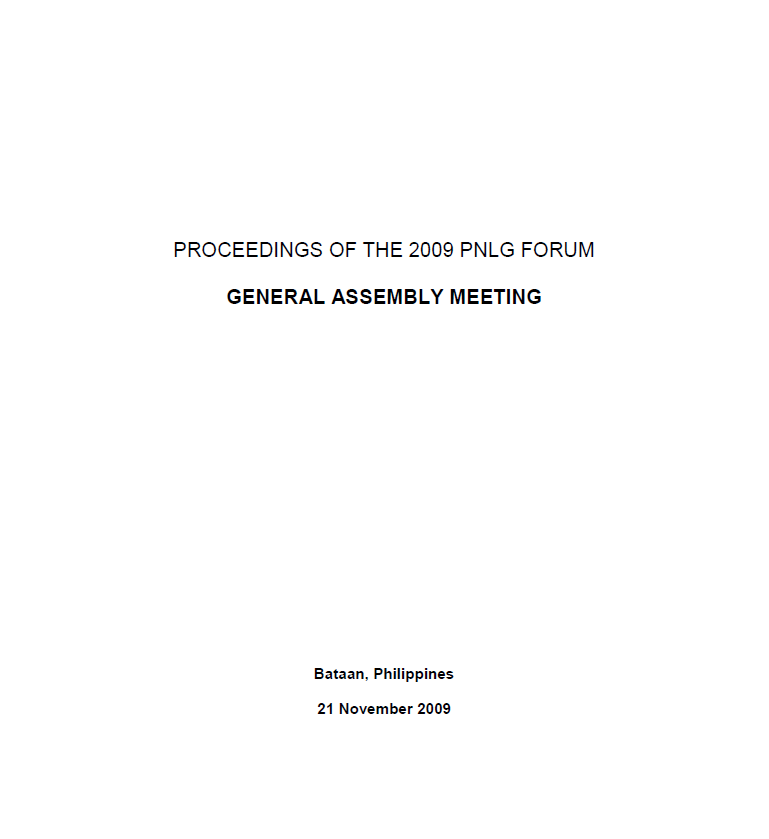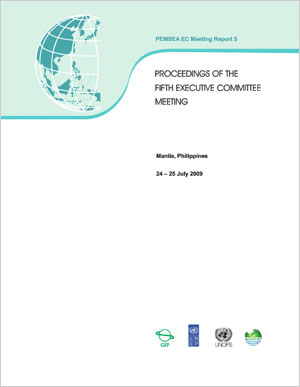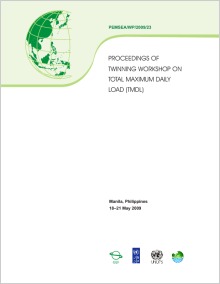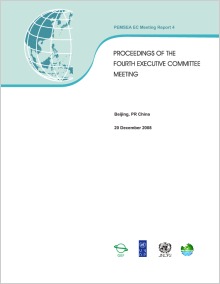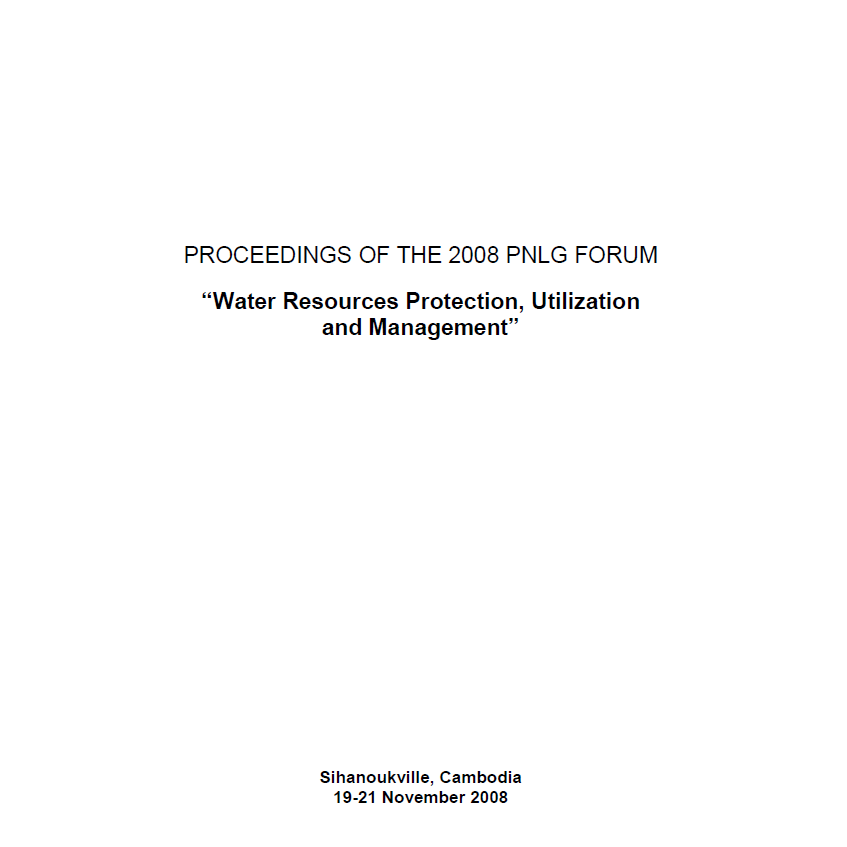
Breadcrumb
Proceedings of the Seventh Executive Committee Meeting
The Seventh Executive Committee Meeting was held at the Oakwood Premier Joy-Nostalg Center, Manila, Philippines, from 26-27 October 2010. The Meeting was attended by the EAS Partnership Council Chair, Dr. Chua Thia-Eng; Intergovernmental Session Chair, Dr. Li Haiqing; and Technical Session Chair, Mr. Hiroshi Terashima. Representatives from PEMSEA Partner Countries participated in the meeting, namely: Cambodia; China; DPR Korea; Indonesia; Japan; Lao PDR; Philippines; RO Korea; Singapore; Timor-Leste; and Vietnam. Representatives from Non-Country Partners were in attendance, namely: Coastal Management Center (CMC); Korea Maritime Institute (KMI); Northwest Pacific Action Plan (NOWPAP); Ocean Policy Research Foundation (OPRF); Oil Spill Response Limited (Oil Spill Response); The Swedish Environmental Secretariat for Asia (SENSA); UNDP GEF Small Grants Programme (SGP); UNEP-GPA; and Yellow Sea Large Marine Ecosystem (YSLME). Representatives from the United Nations Development Programme (UNDP) Manila and the UNDP Regional Centre in Bangkok, GEF Secretariat and The World Bank were present. Representatives from Thailand and the GEF Evaluation Office served as observers. Two experts were also invited to deliver presentations related to PEMSEA’s transformation. The PEMSEA Resource Facility (PRF) served as the Secretariat for the meeting.
Document Number Document Title EC/10/DOC/01a List of Documents EC/10/DOC/02 Agenda EC/10/DOC/03 Annotated Agenda EC/10/DOC/04 PEMSEA Governance EC/10/DOC/05 Financial Report EC/10/DOC/06 Report of the Technical Working Groups on PEMSEA's Transformation
Proceedings of the Third East Asian Seas Partnership Council Meeting
The Third East Asian Seas Partnership Council Meeting was held at the Crowne Plaza Hotel, Dandong, Liaoning Province, PR China, from 26 to 29 July 2010. The State Oceanic Administration (SOA) hosted the Meeting. The Meeting was attended by representatives from ten PEMSEA Partner Countries, namely: Cambodia, DPR Korea, Indonesia, Japan, Lao PDR, PR China, Philippines, RO Korea, Timor-Leste, and Vietnam. A representative from Thailand was present as an observer. Ten representatives from Non-Country Partners were in attendance, namely: Coastal Management Center (CMC); International EMECS Center; IOC/WESTPAC; International Ocean Institute (IOI); Korea Maritime Institute (KMI); Northwest Pacific Action Plan (NOWPAP); Ocean Policy Research Foundation (OPRF); Plymouth Marine Laboratory (PML); PEMSEA Network of Local Governments (PNLG) and UNDP/GEF Yellow Sea LME Project. Representatives from the United Nations Development Programme (UNDP) Manila and the UNDP Regional Centre in Bangkok were present on behalf of the Implementing Agency and the Global Environment Facility (GEF). In addition, a representative from the United Nations Office for Project Services (UNOPS), the Executing Agency for the GEF/UNDP Project on Implementation of the Sustainable Development Strategy for the Seas of East Asia was present, as was a consultant for the GEF IW Stocktaking Project. The PEMSEA Resource Facility (PRF) served as the Secretariat for the Meeting.
PC/10/DOC/10d Concept Paper on the Re-engineering of the PRF
(Document available upon request)PC/10/DOC/15a GEF/UNDP/UNOPS Project on SDS-SEA Implementation (2008-2010)
(Document available upon request)
Proceedings of the Fifth Regional Twinning Workshop on Integrated River Basin and Coastal Area Management: Meeting Challenges of Pollution in River Basins and Coastal Areas
The 5th Regional Twinning Workshop on Integrated River Basin and Coastal Area Management (IRBCAM) with the theme "Meeting Challenges of Pollution Reduction in River Basins and Coastal Areas" was held at the Ibis Hotel, Jakarta, Indonesia, from 17 to 19 March 2010. The workshop was co-organized by Partnerships in Environmental Management for the Seas of East Asia (PEMSEA), PEMSEA Twinning Secretariat/Korea Maritime Institute (KMI), Ministry of Land, Transport and Maritime Affairs (MLTM) of Republic of Korea (RO Korea) and Ministry of Environment (MOE) of Indonesia. The participants were largely officials from the national and local government levels of Indonesia. The resource persons for the workshop were from various organizations and agencies from Indonesia, Philippines, RO Korea, the United States of America (USA), international and national nongovernmental organizations (NGOs), the private sector and donor agencies, including, the World Bank and Japan International Cooperation Agency (JICA). The workshop aimed to share experiences, good practices and lessons learned in planning, developing and implementing pollution reduction investments in Manila Bay (Philippines) and Jakarta Bay (Indonesia) within the context of IRBCAM.
Proceedings of the Sixth Executive Committee Meeting
The Sixth Executive Committee (EC) Meeting was held on 12-13 March 2010 in Beijing, People's Republic of China.The meeting provided an opportunity for discussion and interaction between the EC and the PEMSEA Resource Facility (PRF) on the required changes in operation and decisionmaking as part of the PRF's move from the UN system to a functional regional mechanism.
Document Number Document Title EC/10/DOC/01 Implementation of Previous Executive Committee Decisions EC/10/DOC/02 Post-East Asian Seas (EAS) Congress 2009 Report EC/10/DOC/07 Draft Provisional Agenda of the 3rd EAS Partnership Council Meeting
Proceedings of the 2009 PNLG Forum
GENERAL ASSEMBLY MEETING
Bataan, Philippines, 21 November 2009
A. INTRODUCTION
1. The 2009 PEMSEA Network of Local Governments (PNLG) Forum was held in conjunction with the convening of the 2009 East Asian Seas Congress. The EAS Congress was held on 23-27 November 2009 in Manila, Philippines and hosted by the Government of the Republic of the Philippines, through the Department of Natural Resources and Environment.
2. The PNLG General Assembly (GA) Meeting was held at Lou-is Resort and Restaurant, Balanga City, Bataan, Philippines on 21 November 2010. The GA meeting was hosted by the Provincial Government of Bataan and coorganized by PEMSEA, the PNLG Secretariat and the Bataan Coastal Care Foundation (BCCF), which comprises of private sector partners of the Bataan ICM program.
3. The GA Meeting tackled key issues related to the operationalization of the PNLG including the future role and thrusts of the network, fund management and election of officers. Highlights of the meeting included the induction of Thua Thien-Hue (Vietnam) as the newest member of the PNLG and the signing of the Letter of Cooperation between PEMSEA and the PNLG for the Sustainable Development and Management of Marine and Coastal Environment of the Seas of East Asia.
4. Twenty local governments from 10 countries across the region participated in the forum in addition to the representatives from the East Asian Seas Partnership Council, PEMSEA Resource Facility, the PNLG Secretariat, the private sector and local participants.
5. The participants to the PNLG participated in the EAS Congress and attended the Technical Workshop on Land and Sea-Use Zoning: Opportunities and Challenges on 23 November.
6. The meeting agenda and full list of participants is attached as Annex 1 and 2.
Proceedings of the Fifth Executive Committee Meeting
The Fifth Executive Committee (EC) Meeting was held on 24–25 July 2009 in Manila. The Meeting was organized as an expanded EC meeting, with representatives from 11 Country Partners and 9 non-Country Partners, as well as from the UNDP Regional Centre in Bangkok and UNDP Philippines. The highlights of the Meeting were the recognition of PEMSEA’s international legal personality; the Ministerial Declaration; and PEMSEA’s future role and operating modality.
Document Number Document Title EC/09/DOC/01 List of Documents EC/09/DOC/03 Agenda EC/09/DOC/04 Annotated Agenda EC/09/DOC/05 Implementation of Executive Committee Decisions and Recommendations EC/09/DOC/06 Progress Review: SDS-SEA Implementation EC/09/DOC/09 Senior Government Officials Meeting EC/09/DOC/11 East Asian Seas Congress 2009 Program, Special Meetings and Events, and Exhibition EC/09/DOC/12 ASEAN Centre for Biodiversity as a PEMSEA Partner EC/09/DOC/13 PEMSEA's Future Role and Operating Modality EC/09/DOC/14 The World Bank as a Sponsoring Organization of PEMSEA
Proceedings of Twinning Workshop on Total Maximum Daily Load (TMDL)
The Twinning Workshop on Total Maximum Daily Load (TMDL) was held at the Crowne Plaza Galleria Manila Hotel, Philippines, from 18 to 21 May 2009. The workshop was co-organized by PEMSEA and the Korea Maritime Institute (KMI)/PEMSEA Twinning Secretariat, supported by the Ministry of Land, Transport and Maritime Affairs (MLTM) of Republic of Korea, and hosted by Department of Environment and Natural Resources (DENR) of the Philippines. The Workshop was attended by participants from Indonesia, People’s Republic of China, and the Philippines. Resource persons for the workshop were from RO Korea and the United States. Representatives from the United Nations Industrial Development Organization (UNIDO) and United States Agency for International Development (USAID) were also invited as observers. The workshop aimed to: 1) share good practices and challenges on Integrated River Basin and Coastal Area Management (IRBCAM); and 2) develop TMDL capacity among IRBCAM sites as a means of strengthening pollution reduction planning and implementation.
Proceedings of the Fourth Executive Committee Meeting
The fourth Executive Committee Meeting was held at the Huwan Hot Spring Leisure Hotel in Beijing, PR China on 20 December 2008. The Meeting was attended by the EAS Partnership Council Chair, Dr. Chua Thia-Eng, the Intergovernmental Session Chair, Dr. Li Haiqing and the Technical Session Chair, Mr. Hiroshi Terashima. Prof. Mao Bin, Mr. Liang Fengkui and Dr. Zhang Zaohui of the State Oceanic Administration (SOA) of PR China attended as the representatives of the meeting’s host country. Mr. Takashi Ichioka of the Ocean Policy Research Foundation (OPRF) of Japan attended as an observer. The PEMSEA Resource Facility (PRF) served as the Secretariat.
Document Number Document Title EC/08/DOC/01 List of Documents EC/08/DOC/02 Agenda EC/08/DOC/03 Annotated Agenda EC/08/DOC/04 Progress Report on the Implementation of EAS Partnership Council and Executive Committee Decisions and Recommendations EC/08/DOC/04a East Asian Seas Congress 2009 EC/08/DOC/04b Establishing ICM Learning Centers EC/08/DOC/04c The PEMSEA Trust Fund Management Guidelines EC/08/DOC/04d IUCN-ARO as a PEMSEA Partner EC/08/DOC/05 Recognition of PEMSEA's Legal Personality EC/08/DOC/06 Ministerial Declaration Concept Paper EC/08/DOC/07 PEMSEA's Future Thrusts and Strategy for the Next Phase
Proceedings of the 2008 PNLG Forum
“Water Resources Protection, Utilization and Management”
Sihanoukville, Cambodia, 19-21 November 2008
A. INTRODUCTION
1.1. The 2008 PEMSEA Network of Local Governments (PNLG) forum was held at Sokha Hotel, Sihanoukville, Cambodia, from 19-21 November 2008. It was the seventh of a series of forum conducted since the network was launched in 2001 in RO Korea. The 2008 PNLG Forum was hosted by the Municipal Government of Sihanoukville and focused on the theme “Water Resources Protection, Utilization and Management”.
1.2. The forum aimed to a) share good practices and lessons learned in water resources protection, utilization and management; b) discuss strategies on strengthening water governance and capacity, and b) identify strategies for sustaining the network and expanding its role to support local ICM implementation and scaling up.
1.3. The forum was jointly organized by the Municipal Government of Sihanoukville, PEMSEA and the PNLG Secretariat. Eight local business enterprises provided in-kind contribution for the organization of the forum.
1.4. Twenty two local governments from 9 countries across the region participated in the forum in addition to regional experts/resource speakers from the International Council on Local Environmental Initiatives (ICLEI) Southeast Asia Secretariat, Phnom Penh Water Suppy Authority (PPWSA), Macao Water Supply Co., Ltd., Marine Environmental Research and Innovative Technology (MERIT) of the City University of Hong Kong, Coastal and Ocean Management Instiute (COMI) of Xiamen University and Oil Spill Response and East Asia Response Ltd. (OSRL EARL).
1.5. Representatives from international and national agencies in Cambodia as well as from the academe also participated in the forum.
1.6. The forum was divided into 3 major parts: the opening ceremony, the general assembly meeting and the technical workshop. The forum was concluded by a field trip to key areas in Sihanoukville.
1.7. The meeting agenda and full list of participants is attached as Annex 1 and 2.
